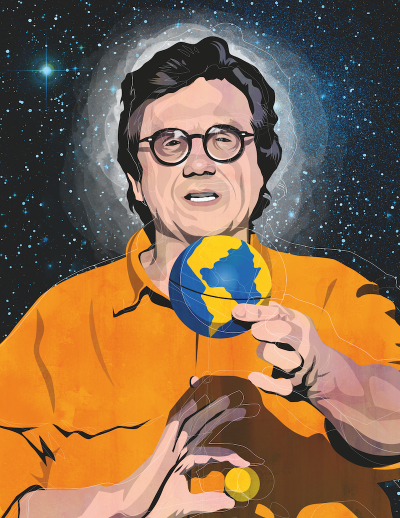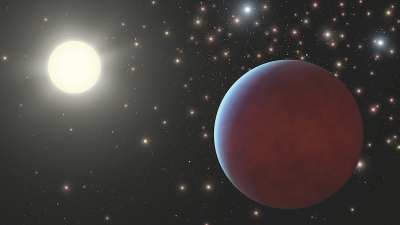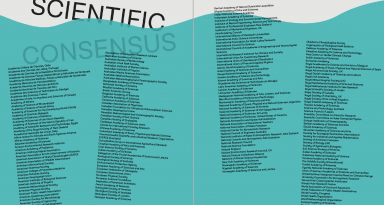Interviewee: Charley Lineweaver
Interviewer: Tim Dean
Tim Dean: Most people are probably familiar with just one atmosphere: our own. How does Earth’s atmosphere compare to the other planets that we know about?
Charley Lineweaver: There’s no place in our solar system today where we could land and then say: ‘Oh, this is nice. We can breathe.’ There’s no oxygen on the Moon. There’s no oxygen on Mars. There’s no oxygen on Venus, Saturn, Uranus, etc. The other planets are not suitable for aerobic respirers like us. There’s an effort that might be made to terraform Mars to get some oxygen in the atmosphere there, but that will take a long, long time, and lots of effort. For the near future, let’s say 1,000 years or so, if you’re going to live on Mars, you’re going to have to live inside a cave or a capsule or a spacesuit of some kind because the atmosphere of Mars is CO2 and we can’t breathe that. Exoplanets are a whole other story that is getting increasingly beautiful and complex. We’ve found thousands and thousands of new planets. A small fraction of them are what you might call wet rocky planets in the habitable zones of their host stars. One thing that determines a planet’s atmosphere is its surface temperature. It’s not enough to be at the right temperature, you need an atmosphere. Take the Moon, for example. It’s in the ‘habitable zone’ of the Sun, but it has no atmosphere. Therefore, there’s no water. Therefore, we’re not interested in it in terms of habitability. But if you made the Moon bigger and bigger, it would become harder for gases like CO2, hydrogen, nitrogen, oxygen, or H2O, to escape. As planets get more and more massive, they tend to have atmospheres. For example, Mars is about one tenth the mass of the Earth. Therefore, Mars cannot hold on to its atmosphere very well, because gravity is what holds an atmosphere on to a planet. However, if Mars were maybe twice as massive as it is today, it would have a thicker atmosphere, and it would maybe have held onto the water that it started out with. Similarly, Venus. If it had not had such a large atmosphere – if it hadn’t been so close to the Sun – it might not have gone through a runaway greenhouse effect, which was probably the reason it lost its water. The atmospheres of exoplanets depend on how far the exoplanets are from their host stars and on whether they are massive enough to hold on to an atmosphere. If a planet is too massive, its atmosphere will be gigantic, like the atmospheres of Uranus, Neptune, Jupiter, and Saturn. There is a sweet spot that some colleagues have called the ‘cosmic shoreline’ between rocks with no atmospheres, and rocks with gigantic hydrogen atmospheres. In between there’s a strip that you might call rocks with modest atmospheres. And that’s the sweet spot in the distribution of exoplanets that we’re looking at very carefully – trying to figure out what the patterns are. The highest mass planets have hydrogen atmospheres. As planet masses get smaller, they probably have thick water atmospheres. Even lower mass and you start to have atmospheres like we have on Venus, Mars, and Earth. And if you get even less massive – and cold – you have atmospheres made out of nitrogen and argon, like Pluto’s. Small planets far away from their host stars can be so cold that their gases are easy to hold on to. So, there’s a kind of a trade-off. High masses and cold temperatures allow a planet to hold on to its atmosphere, while low masses and high temperatures make it easier for the atmosphere to escape. The atmospheres of exoplanets depend on how far the exoplanets are from their host star and on whether they are massive enough to hold on to an atmosphere. Those are the two variables you need to keep in mind when you’re thinking about rocky planets with atmospheres: mass and temperature. We’re trying to figure out what the details of this trade-off are among the exoplanets we’re detecting.
Let me ask about one planet that we do know quite a lot about, which is Venus. Venus has a lot of physical similarities to Earth. But Venus’s atmosphere is very different from ours. It’s much more dense and the surface temperature is over 460 degrees Celsius. How did it diverge so much? Was it once more like Earth’s atmosphere?
Yes, the data suggests that Venus was like Earth about four billion years ago, maybe even three billion years ago, maybe even more recently. Some people think there might have been life on Venus. Earth is at 1 AU [astronomical unit, the distance from the Earth to the Sun]. Venus is at 0.7 AU. When you calculate how much sunlight Venus receives, you take the inverse square of that distance, which means that Venus gets about twice as much sunlight as Earth. On the other hand, Venus has clouds that are very reflective, so its albedo is very high. And so Venus reflects a lot more of sunlight than Earth does. But Venus’s atmosphere is also very thick and full of CO2, which is a strong greenhouse gas. It had a runaway greenhouse effect, which is why Venus is so different from the Earth. It’s something that we might become more familiar with if we keep on burning fossil fuels, increasing the CO2, and thus produce a runaway greenhouse on Earth.

What would Earth’s atmosphere look like if life had not evolved here?
That’s a difficult question. Life has played a very important part in changing the Earth’s atmosphere. For example, 2.3 billion years ago there was the Great Oxygenation Event, and the oxygen levels went from almost zero to around one per cent. That’s a large increase. And then somewhere just before the Cambrian it went up again. And so the oxygen content that everybody thinks is very important – because that’s what you’re breathing right now – has changed enormously. Also, I’m looking at a bunch of clouds right now. And the trees out there, they’re doing what’s called evapotranspiration. They’re taking lots of water from the soil and putting it into the air, and that turns into clouds. So, let’s think about the Earth with life and without life. Let’s say that the water content is the same. I’ve heard some people who study this say there might be twice as many clouds in the atmosphere because of life compared to a planet without life. That’s important because low clouds reflect sunlight. They cool the Earth. But high clouds have the opposite effect. H2O vapour acts as a greenhouse gas. So the effect of clouds is incredibly complicated and the people who are trying to make climate predictions are always wrestling with these two contradictory influences of H2O in the atmospheres.
What about the future of Earth’s atmosphere? Because changes happen very slowly, relative to human lifespan, we tend to feel as though things like the atmosphere are relatively stable. But we know that they do and will change. What can we expect from the future of Earth’s atmosphere in the near term over maybe hundreds or thousands of years, and then the very long term over millions of years?
We know that the Sun will turn into a red giant and engulf the Earth or make it unbearably hot in about six billion years. We are very sure of that. On the other hand, the luminosity of the Sun continuously increases. That will have the effect in about half a billion or a billion years of removing the water from Earth. Losing the water on Earth is something that is really bad if you’re a life form. And so it looks like a billion years would be how long we have before the increasing luminosity of the Sun dries out the surface of the Earth. People say that’s a long time. Well it’s short cosmologically, but it’s very long in terms of a human lifetime. It seems to be the case that the CO2 content of the Earth has been decreasing over a billion-year timescale; you may have heard of C3 or C4 photosynthesis. C4 is better at grabbing CO2 out of the atmosphere. And this is a way in which some plants have adapted over the last 100 million years or so to a decreasing level of CO2. It may be that some kind of Gaian regulation is going on: the biosphere may be trying to keep the temperature in a regime comfortable for life by decreasing CO2. As CO2 goes down, the greenhouse effect decreases, cooling the atmosphere. Meanwhile, the luminosity of the Sun is going up, and so they compensate for each other and therefore the temperature stays about right for life. That’s one idea. Some people think that’s baloney and other people think it makes sense. So, it’s a hard thing to test. But in the long term, CO2 is going down except for the fact that we are burning all these fossil fuels. We can’t keep on doing this for very long. I’m not sure how long people will continue to burn fossil fuels, maybe 50 or 100 years, or maybe 1,000 years. But that’s a blip. That’s nothing compared to the billion-year timescales that I’ve been talking about. Over the past billion years, the biosphere may have reduced the amount of CO2, to keep the Earth cool despite the increasing luminosity of the Sun.
If we do continue to pump enough greenhouse gases into our atmosphere to reach a tipping point and start a runaway greenhouse effect, what would that do to our atmosphere?
The most optimistic thing I can say about that is look at the past million years on Earth. Look at the ice cores from Antarctica or Greenland and see how the temperature has varied, and what caused that variation. And keep in mind that for most of Earth’s history, we have not had polar ice caps. Having polar ice caps is what you get when you are in a glacial period and it’s cold. Now, that doesn’t mean that humans are not having an effect. It’s just that the natural variability over, for example, the last hundred million years is gigantic. For example, the sea level goes up and down by hundreds of metres. And this is a very natural thing that has nothing to do with humans. On the other hand, we know that humans are changing this natural variation. For example, right now sea levels would probably be going down, but because we’re emitting so much CO2, they’re going up. If you look at the variability over 100 million years, so far humanity has changed the temperature or the sea level maybe 10% or less of what you would expect to see over the hundred-million-year time-scale. So, for example, during the Palaeocene-Eocene Thermal Maximum 56 million years ago it was 8 degrees warmer than it is now on average. That’s a lot. But the problem with what humanity is doing is we’re changing things on a much faster timescale. That’s the issue. That is unprecedented, as far as I can see. People should recognise that the Earth has changed enormously on long timescales. In the last million years or so you see these glacial and interglacial periods, and ice ages coming and going, the polar ice caps increasing and decreasing in size. Those things are natural. But they’re natural if they’re taking 100,000 years, not 100.

How has the research you have done, and the thinking along cosmological timescales, changed the way that you look at our own planet and what we’re doing to it?
Well, it’s kind of like living in a neighbourhood and then getting a map of the neighbourhood, and then getting a map of the country, and then getting a map of the Earth, and getting a map of the solar system. It gives you a perspective from further away. It gives you an overview that almost makes you feel that you’re no longer a part of it, or that your part of it is tiny and less significant. I guess it makes you a little bit more humble. I think. I hope. That’s the feeling I get about the Earth from studying other planets. The idea that there are many billions and billions of other planets like Earth out there, well, what does that say about humanity on Earth? A lot of people think human-like intelligence is a convergent feature of evolution. Therefore, we should expect all kinds of technological aliens out there. But we haven’t heard from any. I think one of the most important things to keep in mind is that the timescale is really important. When you talk about what’s happening in the atmosphere, are you talking about day-to-day, or a seasonal timescale or a decadal timescale? Or a 1,000-year, 10,000-year, hundred-thousand-year, a million-year, ten-million-year timescale? These are hugely different. When you talk about the differences that have happened to Earth’s atmosphere over the last hundred million years, they are enormous compared to anything that we are doing to it in the next decade or three. And so you might think it doesn’t matter what humans do. Nature does that itself. It’s not that warming has never happened before. It has. What is new is the rate at which it is changing. That’s crucial for biology, because if change happens slowly, biology can adapt. If change happens quickly, species can’t adapt quickly enough to keep up. And so you run into problems associated with the wonderful things that species do for each other. The biosphere is all connected and there’s a nice network that compensates and buffers things. But if you turn the temperature up, turn the thermostat up by one hundred degrees, then life will die except for some bacteria, and then things will be enormously changed. It all depends on the rate of change, not necessarily the amount of change.
Dr Charley Lineweaver is Senior Fellow at the Planetary Science Institute at the Australian National University.
< 6 thinkers | Degree is shaked >





































